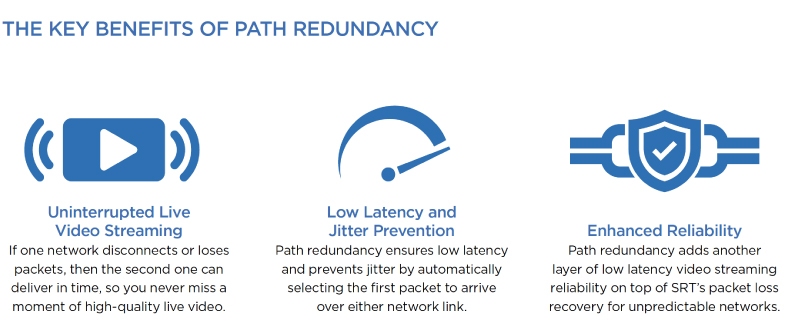Already well-known in the industry for their rock-solid reliability and resiliency, Haivision’s Makito X4 Video Encoder and SRT Gateway video stream router, now include Path Redundancy, a hitless failover feature that ensures uninterrupted low latency real-time video transport. In this post, we’ll explain how exactly this important new feature works, as well as the benefits it offers to users.
What is Path Redundancy?
Path Redundancy is a new feature from Haivision included with the Makito X4 and Maktio X4 Rugged video encoders as well as the SRT Gateway stream routing solution. Path Redundancy is a type of hitless protection and failover technology that relies on more than one IP network path to prevent disruption to live video streams, in the event of network congestion or outages, by maintaining continuity of service.
Path Redundancy increases the reliability of live contribution, content distribution, and edge to cloud workflows, allowing them to leverage multiple network paths to ensure that live streams are successfully transported from one location to another. Path Redundancy enables continual routing of live video streams even if one IP network path fails or experiences temporary issues such as packet delivery delays and sudden bandwidth constraints, ensuring high-quality feeds for must-not-fail event coverage or mission-critical ISR applications.
Similar to SMPTE-2022-7 over managed networks, Path Redundancy adds seamless stream protection and hitless failover to Haivision solutions. When combined with the already reliable nature of the Secure Reliable Transport (SRT) protocol, Path Redundancy makes live video transport over the internet an extremely reliable and cost-effective option compared to using satellite links or dedicated fiber.
How Does Path Redundancy Work?
Path Redundancy can route live SRT streams over two or more network paths in real-time. Each network path can use its own combination of IP address and port number or IP socket. Ideally, each network path should be sent over separate NICs (network interface cards). Haivision SRT Gateway appliances include two ethernet NICs, while the Makito X4 video encoder supports a second NIC via an SFP adaptor. Using separate NICs enables an SRT stream to be routed over completely separate IP networks, typically two different ISPs or two different datalinks. The two active paths take different routes but are sent to the same receiver. The receiver (SRT listener) accepts the first packet to arrive, over either network.
What are the Benefits of Path Redundancy?
Whether for live coverage of premium sports and news events, real-time ISR video streams, or global video production collaboration, Haivision Path Redundancy provides a high level of reliability and peace of mind to broadcast engineers and network operators.
As Corey Behnke, co-founder and producer at Live X, a full-service production company in New York, explains “For those just-in-case moments when you never know what’s going to happen, Path Redundancy in an incredibly valuable and must-have feature for broadcasters to insure against potential failures.”


